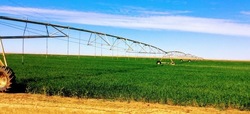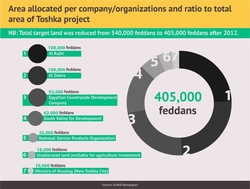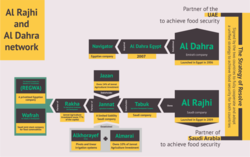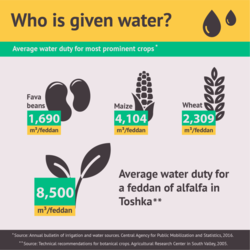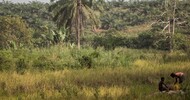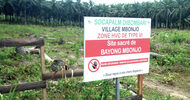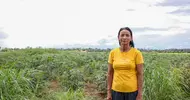By Nada Arafat and Saker El Nour
Vast expanses of green extend across the horizon, tended by the advanced machinery that has replaced hundreds of agricultural workers. The land is watered using center-pivot irrigation systems, connected to one another in a series of canals through which water is driven by one of the biggest water pump stations in the world. A number of engineers oversee the expansion works to cultivate new fields of alfalfa on land run by one of several Gulf investment companies in the Toshka project.
This is Egypt’s Western Desert, an area where rapid changes are in full swing to make green what was mostly sandy desert two decades ago.
The desert’s greening is part of an agricultural development and investment initiative framed as aid to the Egyptian people. But in fact, Gulf corporations acquired most of the land as part of the oil-rich countries’ plan to ensure their food security by cultivating land outside their borders.
The scene today is the culmination of the moment when Gulf countries realized the importance of preserving their already scarce water resources. In January 2009, the Kingdom of Saudi Arabia launched the King Abdullah bin Abdulaziz initiative for agricultural investment abroad, outlining plans to achieve food security by investing in countries with agricultural potential.
This initiative included offering financial support to Saudi investors, with the government covering up to 60 percent of construction and production costs. The government also committed to negotiating bilateral agreements with other governments to facilitate business for investors abroad and secure the export of at least 50 percent of their produce to the kingdom.
This long-term agricultural strategy evolved with one ministerial decision after the other, starting from limiting wheat cultivation in 2005. A 30-year program of wheat production and cultivation in the kingdom then decreased gradually until it was completely halted in 2008 due to concern over the depletion of water resources. Last year, while the Saudi government lifted the ban on wheat farming under certain conditions, the cultivation of green feed was completely banned as it consumes up to six times more water than wheat.
Saudi Arabia wasn’t the only Gulf country with an impending water crisis. The United Arab Emirates was also facing diminishing water resources and turned to importing about 90 percent of its food. The UAE thus also began to push for investment in farming ventures abroad.
Facing similar challenges, the two countries jointly announced “The Strategy Of Resolve” last year to strengthen economic, political and military cooperation. This includes establishing a unified strategy for food security, with plans to harness the full potential of agricultural and livestock production and to work together on joint projects.
In the last few years alone, the Emirates has managed to gain control over almost 4.25 million feddans of land spread out over 60 countries, while Saudi Arabia now controls about 4 million feddans around the globe.
Some define the rush by richer countries to buy or lease large expanses of land in countries with agricultural potential as a form of neocolonialism, which achieves food security for the investing countries while exploiting non-renewable resources, including water, in the farming countries.
Gulf investors found their panacea in Egypt, which is increasingly adopting a capitalist agricultural production model that prioritizes investment in large-scale, modernized farming to export crops over pursuing strategic crop cultivation and traditional farming methods in the Nile Valley and Delta.
“Come along with me
around Egypt to see
what has become of our country,
a different picture than two years ago, or three.
Between two reigns, I do not compare, or despair, or shout in glee.
It’s my children’s right to see
Egypt, my country,
in the millennium, shining new as can be.”
So went the anthem played on all state-run Egyptian TV channels in early 1997 during the visit of former President Hosni Mubarak to Egypt’s Western Desert, just 225 kilometers south of Aswan. In what became an iconic photograph of the Mubarak era, he can be seen raising his hands in salute to the engineers to inaugurate the Toshka project.
The project’s plan was designed to start construction in 1997 through to 2017.* The main objectives were to erect a new Delta south of the Western Desert, add up to 1 million feddans of farmland, create new industrial and residential communities, and generate 45,000 new jobs every year to accommodate 4-6 million Egyptians in 10 years.
*Source: Sims, David E. Egypt’s Desert Dreams: Development or Disaster? Cairo: American University in Cairo Press, 2018.
But years have gone by, and Egypt has not noticeably benefited from the Toshka project. The crisis of overpopulation in the Nile Valley and the issue of food security remain unresolved. The project has, however, achieved considerable success for some foreign investment companies.
The Emirates gained a foothold in the project as early as 1997, with a $100 million donation made through the Abu Dhabi Fund for Development. The money went toward constructing and lining the project’s main water canal. Extending for about 51 kilometers, it has since been renamed the “Sheikh Zayed Canal” after the ruler of Abu Dhabi.
The concerned authorities earmarked one-tenth of Egypt’s total quota from the Nile’s water (5.5 billion cubic feet out of 55.5 billion cubic feet) for the project. A 250 MW pumping station was built to pull the water from Toshka valley, which is linked to Lake Nasser and filled from flood water, to the Sheikh Zayed Canal, which then feeds four branches extending along the areas to be “reclaimed.”
In 2003, water was pumped into this canal for the first time, bringing with it an influx of Gulf investors into the Toshka area. The project currently spans about 405,000 feddans, 100,000 of which are owned by the Saudi-based Al Rajhi International for Investment company and another 100,000 owned by the Emirates-based Al Dahra for Agricultural Development company.
Egypt also owns shares in the project: 25,000 feddans are currently under the administration of the Egyptian National Service Products Organization, which bought the land from Al-Waleed bin Talal’s KADCO [Kingdom Agricultural Development Company] in 2017. Another 62,000 feddans are under the South Valley for Development and 92,000 feddans have recently been allocated to the Egyptian Countryside Development Company — both of which are state-owned agricultural reclamation companies. Ten thousand feddans of land were also allocated to the Ministry of Housing to create New Toshka City, while 16,000 feddans are yet to be allocated.
The two Gulf-owned companies, Al Rajhi and Al Dahra, thus control about 49.4 percent of the total land developed under the project.
The Gulf investment companies acquired the land in Toshka through a land deal, whereby the company acquired ownership of the land in phases. The number of feddans to be reclaimed in each phase is agreed upon, and, after the completion of each phase, the land ownership is transferred to the company until the company eventually owns the entire allocated plot.
A report published by the Central Auditing Authority in 2014 states that the land was sold for just LE50 (US$3) per feddan, while the projected market price at that time was estimated at LE11,000 (US$635) per feddan. The Egyptian government footed the bill to develop all of the infrastructure of the canal system, while the investors covered the costs of agricultural reclamation and completing the construction of branches from the irrigation canal, drainage systems and water pumping stations on the land they had acquired.
A complex investment network
The Gulf’s network of agricultural investment in Egypt is quite intertwined, as the business interests of private investors from both Egypt and the Gulf intersect with the broader political and economic ties between Egypt and the Gulf countries.
Al Rajhi Investment Group is a Saudi-based corporation owned by the Al Rajhi family. It was founded by Sulaiman al-Rajhi and is one of the main partners in King Abdullah’s foreign investment initiative. It entered the Egyptian market in 2009.
Currently, Al Rajhi owns Tabuk Agriculture Development Company. which is, in turn, a partner in the Saudi Arabian conglomerate Jannat Agricultural Investment Company. Six other Saudi-based companies working in agricultural investment fall under the purview of Jannat, including Al Kharif for pivot irrigation systems and Almarai.
The Saudi Jannat Agricultural Investment Company owns about 78 percent of shares in the Egyptian company Rakha for Agricultural Investment, which owns the Egyptian government entity REGWA, an irrigation systems company that has been accused of corruption and land grabbing in multiple lawsuits.
Rakha for Agricultural Investment is also affiliated with Wafrah for Industry and Development , a Saudi-based company that works in food production.
Al Dahra is an Emirati corporation specializing in agriculture, as well as the production and supply of animal feed to the Food Security Authority of the UAE. It is also owned by royal family member Hamdan bin Zayed Al Nahyan, the ruler’s representative of Abu Dhabi’s Western Region, making the corporation heavily involved in the government’s plan to implement the Emirates Strategic Food Security Program.
The company began operating in Egypt in 2006, establishing Al Dahra Egypt in 2007. It cooperated with the Egyptian and Emirati governments through its acquisition of the Egyptian company Navigator for Agricultural Investment.
Both Al Rajhi and Al Dahra have strong ties with their respective governments and are deeply involved with the foreign agricultural investment initiatives launched by Saudi Arabia and the Emirates, like the “Strategy of Resolve.”
Since the launch of the Gulf Food Security initiative, the Emirati company Al Dahra has seized control of 400,000 feddans worldwide, including 116,000 in Egypt’s Toshka, East Oweinat, Salheya and Nubaria regions alone. The Saudi Al Rajhi has 120,000 feddans in Mauritania and is planning to acquire 450,000 feddans in Sudan, in addition to the 100,000 feddans it has acquired in Toshka.
A handful of lawyers have filed lawsuits against some of the aforementioned companies, contesting that some of the contractual terms had violated Egypt’s Constitution and squandered the country’s resources. According to a lawyer who worked on one of these lawsuits, major corporations often operate under a web of entangled investment interests as a strategy in order to gain complete monopoly over the market under the guise of multiple companies.
The lawyer, who spoke on condition of anonymity, says that this strategy also helps cover up how much control a certain investor exerts over the market, because the share is distributed over several companies, which also makes tax evasion easier.
This arrangement ensures benefits for all entities involved. For example, the Saudi company Al Rajhi, which grows alfalfa, a grain cultivated to feed livestock, is an affiliate of Almarai, a dairy production company. It’s also an affiliate of Alkhorayef, which works in irrigation systems. All of these companies operate under the Saudi agricultural investment conglomerate Jannat, which helps them expand their market share and meet their supply demands. It also facilitates indirect deals with other companies like Wafrah, a Saudi food products company that makes grains and pasta, and Marina, an Egyptian company that works in animal feed production. This investment strategy aims to control the entire food supply chain, starting from the production materials to the production and industrial processing and, lastly, the market in order to exert complete monopoly over food commodities.
Suspicious contracts
The contracts between the Egyptian government and Gulf investors, particularly in Toshka, are rife with violations, according to information released in previously published media reports, as well as copies of the official documents obtained by Mada Masr.
It all began with a deal made between the Egyptian government and Saudi billionaire investor Al-Waleed bin Talal in 1998. At the time, his Kingdom Holding Company was the first Gulf investment company to buy land in Toshka, acquiring 100,000 feddans at LE50 (US$3) per feddan, bringing the total to LE5 million (US$289,000), only 20 percent of which was paid on the date of signing the contract. No other details are mentioned in the contract concerning the payment method for the remaining amount, and it remains unknown if any other installments were paid after that. The contract allowed the investor to cultivate any crops desired without needing prior approval from the concerned ministries. It also gave the company the right to import seeds as well as plant and animal strains without needing official clearance. The clauses further granted the investor total tax exemption.
After coming under intense scrutiny in the wake of the 2011 revolution, some of the contractual clauses were modified, and bin Talal’s company agreed to return the portion of the land which had not yet been reclaimed and which comprised 75,000 feddans in total. In 2017, the Egyptian Armed Forces bought the remaining 25,000 feddans from bin Talal for LE1.25 million.
Similarly in 2011, the Egyptian Center for Social and Economic Rights filed a lawsuit against Al Dahra calling for the annulment of the contract. The lawsuit stipulated that the sale of 100,000 feddans of land in Toshka to the company involved gross squandering of public funds and the sale of state land at a lower price than the estimated market price, since the land was sold at LE50 (US$3) per feddan at a time when the average land price was LE11,000 EGP (US$637) per feddan. According to subsequent reports released by the center, the Egyptian State Council released a statement recommending the annulment of the contract. However, the Public Prosecutor’s office never pursued further investigations, and the case was closed without a verdict.
Despite these lawsuits, Egyptian law currently prevents any third parties from legally contesting the contractual arrangements made between the government and investors, except for parties who have an invested stake in the contract. This law was passed when former interim President Adly Mansour approved some amendments to the investment law affecting litigation rights in 2014.
In addition to the violations alleged in the contractual arrangements, violations extend to meeting contractual obligations and the actual process of land reclamation on the ground.
For example, Al Rajhi received 25,000 feddans out of the 100,000 feddans it had been contracted to reclaim over five phases. In early 2010, the company submitted a request for inspection, claiming it had completed the reclamation process for the first 25,000 feddans. Last year, the General Authority for Agricultural Development Projects approved the handover of 17,000 feddans to the company in order to commence the second phase of agricultural reclamation on the grounds that the company had indeed completed the first phase, which had been set at 25,000 feddans. However, an analysis of satellite imagery reveals that this is not the case, as the total area cultivated in 2013 was about 6,000 feddans, and, in 2019, has come to 10,402 feddans.
Another violation against Al Dahra was revealed by a source inside the Center for Water Research in Abu Simbel, where satellite imagery shows that the company cultivated the entire 18,351 feddans of the land with alfalfa, in violation of the contract, which stipulates that only 5 percent of the plot could be cultivated with alfalfa.
While Hamdy Abdel Dayem, the official spokesperson for the Ministry of Agriculture, affirmed to Mada Masr that most contracts limit investors to cultivate only 5 percent of land with alfalfa in order to protect water resources, MP Raef Temraz, the former deputy for the parliamentary committee on agriculture and irrigation, declared that the alfalfa cultivation made up 25 percent of the total cultivated land in Toshka and the New Valley governorate. Temraz noted how alfalfa is exported in huge quantities to a number of Arab countries, chiefly Saudi Arabia and the United Arab Emirates.
Waste at all levels
Gamal Seyam, a professor of agricultural economy at Cairo University, recalls how the Ministry of Irrigation only approached the university to conduct feasibility studies for the Toshka project two years after it was launched, in the wake of growing talk in the public sphere that the project had failed.
Seyam explains how that high value crops, such as fruit and vegetables, are usually a more viable economic option in land reclamation schemes, since they can be further processed, which creates added value, jobs and enhances national income.
He states that this type of foreign investment gives zero return to the state because it allows investors to buy the water for cheap, acquire land at a low cost and export most of their produce. Furthermore, the capital for these corporations is not based in Egypt. Thus, there is no real benefit to the national economy.
For Seyam, the state should make deals with investment companies based on long-term economic analysis rather than aiming for short-term financial gains, since these types of arrangements allow Gulf corporations to establish zones and to take sovereignty over Egyptian land. Seyam questions the government’s decision to sell state land to foreign investors at LE50 (US$3) per feddan, while, one feddan of desert land is worth up to LE40,000 (US$2,311) currently. “Even if this price was justifiable in order to promote investment, why afford this advantage to a foreign investor?” Seyam asks.
In an economic feasibility study he prepared, Seyam explains how the total area cultivated by both companies was about 29,000 feddans. The average amount of water consumed is about 210 million cubic metres annually, while the companies pay the Ministry of Irrigation about LE20 million (US$1.2 million) annually. If we estimate that the market price for a cubic meter of water is LE2 (US$0.12), this means that the investor purchased water worth LE420 million (US$24.3 million) for just LE20 million (US$1.2 million).
This “water grab” is not limited to the 29,000 feddans which make up the currently cultivated area of land, but extends well into the future when the two companies will own 200,000 feddans between them. Seyam’s analysis is confirmed by a source working at one of the two Gulf-owned companies in Toshka, who quotes one of the Emirati alfalfa importers as saying: “We’re buying water, not alfalfa.”
The same amount of water, around 210 million cubic meters, says Seyam, would be sufficient to cultivate 84,000 feddans of wheat, thus raising Egypt’s production of a strategic crop by about 62,000 tons. Egypt consumes about 16,000 tons of wheat annually and is the world’s largest wheat importer. Last year, it imported about 6 million tons of wheat.
In official statements about agricultural acquisitions, investors stress their concern with preserving water resources and the long-term sustainability of their projects through producing crops for local consumption. In Egypt’s case, the government has pressured the companies to cultivate wheat as one of the strategic crops that sustains most Egyptians. However, the government has failed to supervise the companies to ensure uptake of wheat. According to a source working at one of the Gulf companies in Toshka, who spoke on condition of anonymity, the total wheat produced by the company was only 15,000 tons, meaning that the total area cultivated with wheat was only about 6,000 feddans.
At the same time, Saudi Arabia decided in 2007 to reduce and regulate its water consumption through importing large quantities of alfalfa, which is used in animal feed. Since alfalfa is one of the most water intensive crops (each feddan of alfalfa requires about 8,000 cubic metres of water to cultivate), the Saudi Council of Ministers passed a decision in 2011 forcing dairy farms to import animal feed equivalent to their export of dairy products. In 2015, the council enforced a complete ban on animal feed cultivation. This means that Saudi dairy farms are almost completely reliant on imported animal feed from its agricultural investments abroad, in countries such as Egypt.
For its part, the strategy of the Egyptian Agricultural Ministry for 2030 aims to save more water through developing the irrigation system in the Nile Delta and cutting down on the cultivation of some strategic crops, like rice — a mainstay for Egyptian farmers who consider it one of the most profitable crops. Under this strategy, the state will save up to 14.5 billion cubic meters of water from lands in the Nile Valley and Delta, and some of this water will be used in the irrigation and cultivation of the various land reclamation projects adopted by the government. In essence, the government is taking water from local farmers and rerouting it to foreign investors so that they can grow alfalfa and export products, all the while draining state resources.
This drain on the country’s resources by these companies further extends to energy. The foreign investors’ modern mode of production requires a huge amount of energy to deliver water to the area, distribute the water on the farms and power irrigation channels. A source at one of the farms run by Al Rajhi estimates that the company consumes about 1.5 million kilowatts per month, while Al Dahra consumes about 2 million kilowatts per month. This means that the energy consumption of both companies combined is about 28 percent of the energy required to power Line One of the Cairo Metro, which is 12.5 million kilowatts per month.
Despite the sprawling areas of land owned by the two Gulf companies, the total labor force of each does not exceed 200 workers and employees, according to a source inside one of the companies. The number is extremely low compared to the labor power needed to cultivate similar areas of land in the New Valley governorate and the Delta. It also contradicts one of the most important goals of the Toshka project, which is to generate 450,000 jobs per year and house 4 to 6 million citizens through developing urban settlements in those regions.
Egypt is not the only country that has been the target of agricultural land acquisitions by Gulf-owned corporations. But some countries have started to curb this type of investment. Sudan, the number one country leasing agricultural land for animal feed cultivation, has recently refused to accept any further agricultural investment ventures after some Sudanese Parliament members expressed their concern about the depletion of the country’s underground water resources. In 2013, Sudanese protesters rose up in several demonstrations to refuse land appropriation to Gulf investors, and anger over the loss of land has resurfaced in light of the ongoing protests in Sudan.
Sherif Fayad, a professor of agricultural economics at the Desert Research Council, explains that the problem with desert reclamation in Egypt is the absence of a strategic vision by the state to harness the region’s potential. It is important for there to be complementarity between what is cultivated in the desert and what is cultivated in the Nile Valley and Delta in order to make optimum use of the available resources, he says. It makes sense for the old Nile Valley to remain the hub for the cultivation of strategic crops and crops important for local industry, because some crops are labor-intensive (such as cotton), while others require heavy fertile land (like wheat), or plenty of water (like rice), he says. Also, the end market for these crops is in close proximity to where they are cultivated and processed. As for desert land, it is best allocated for production of citrus fruits and some other fruit, such as grapes, pomegranates, and guava, in addition to some aromatic plants or greens that don’t require too much water, Fayad says.
Egypt lacks any kind of institutional policy that seeks to protect the rights of communities or any form of collective participation that involves local communities in determining which crops to cultivate and how to best manage resources in the most viable sustainable manner, he says.
Any investor comes with an agenda aimed at gaining maximum benefits out of the deal, but the state must also pursue its own agenda in dealing with the private sector, Fayad says. It must have a mechanism to force investors to comply with its demands. The investor provides money, expertise and technology. In exchange, the state gives land, water, energy, cheap labor, electricity and a suitable climate. All these resources belong to the people.
While the investors get a return on their money through the land acquisitions, nothing will make up for the water, the land and the repercussions of climate change, Fayad says.
“If it’s going to be like that, why don’t we just rent out the country?” he asks, adding that the investors’ clear vision in the absence of any sort of vision by the state is what leads to the people losing their rights.
This story about the acquisition of Egypt’s natural resources to secure Gulf food was made possible with support from InfoNile and Pulitzer Center.


